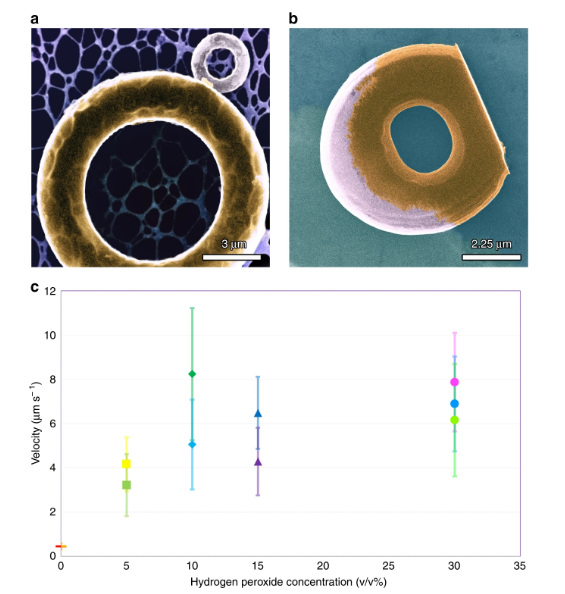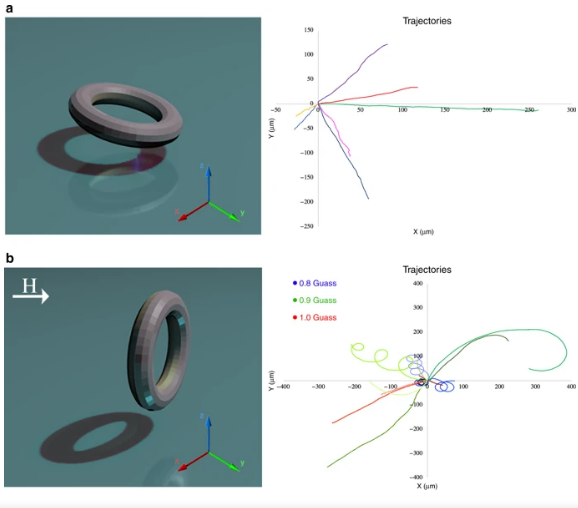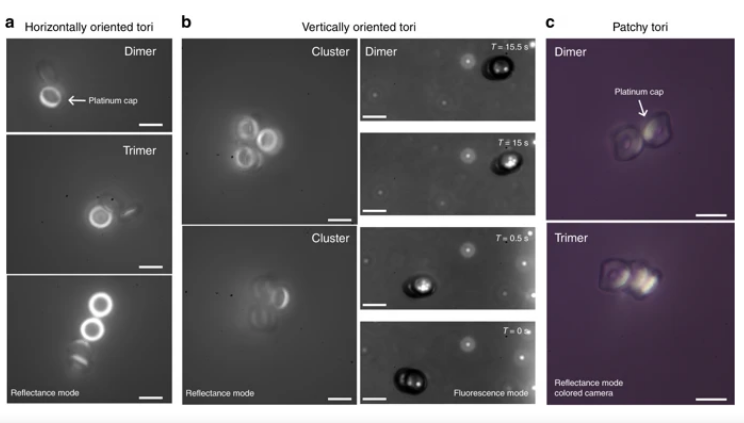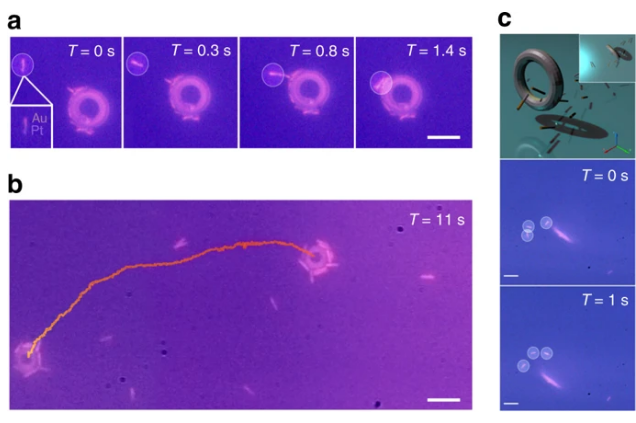In the recently published ‘Shape-programmed 3D printed swimming microtori for the transport of passive and active agents,’ international researchers explore the challenges in mimicking the ‘unique swimming behaviors’ of microorganisms—for the purposes of microfabrication. With 3D printing on the nanoscale, however, they have been able to design microscopic tori for transporting biological matter.
Active matter systems are becoming more interesting to researchers as a topic of study, but to be functional they must be able to adapt to their environment, must be capable of complex behavior, and able to function as self-propelled swimmers.

Tori with two types of surface coating. a A High-resolution transmission electron microscope (STEM) image of “glazed” Janus torus on a carbon lacey TEM grid. The metallic cap has been applied to the top of the tori. The scale bar is 3 μm. b SEM image of a “dipped” Janus tori on a carbon TEM grid. The bottom of the torus is “cut off” at the bottom to provide a stable base during printing and the metal evporation. The scale bar is 2.25 μm. c A graph representing the propulsion velocity dependence on the concentration of hydrogen peroxide. Red and orange horizontal bars are respectively the propulsion velocities glazed and dipped tori (with 40 nm Ni and 10 nm Pt) on a gold substrate at 0% H202. Green and yellow squares are respectively the propulsion velocities glazed and dipped tori (with 40 nm Ni and 10 nm Pt) on a gold substrate at 5% H202. Dark green diamond is the propusion velocity of glazed tori (with 40 nm Ni and 10 nm Pt)on a glass substrate at at 10% H202; and comparitively,teal diamond is the propulsion velocity of dipped tori (with 40 nm Ni and 10 nm Pt) on a gold substrate at 10% H202. Purple and dark blue triangles are, respectively, the propulsion velocities glazed (with 40 nm Ni and 10 nm Pt) and dipped tori (with 10 nm Ni and 40 nm Pt) on a gold substrate at 15% H202. Magenta, lime, and ice blue circles are the propulsion velocity of 3 μm diamater glazed tori, 7 μm glazed tori, and 7 μm dipped tori at 30% H202. The three tori have a coating of 40 nm Ni and 10 nm Pt. A full legend can be found in Supplementary Fig. 3 and in Supplementary Note 2. The error bars represent a unique standard deviation for that particular sample
“Bacterial systems show a wide variety of complex behaviors, including spontaneous alignment in the presence of chemical gradients and altering rheological properties of the fluid,” stated the researchers. “Translating these complex behaviors to artificial systems is especially attractive for applications in fluid transport, small-scale mixing, and targeted cargo delivery but is hard due to intrinsic nanofabrication limitations.”
Many of the simplest constructs so far have proven to be inferior in terms of swimming and other behavior—making it obvious that greater strides must be made before such particles become a functional reality for scientists. In this project, the researchers created swimming tori manipulated by a magnetic field. These constructs were able to transport the following:
- Other artificial swimmers
- Bimetallic nanorods
- Passive colloidal particles
They created a hydrodynamic and propulsion mechanism independent model ‘to account for the new emergent phenomena in swimming microtori near boundaries,” along with pinpointing the elements required for swimming—self-induced slip velocities across the surface and electrostatic potentials. This left the team open to experimenting further with alternative mechanisms, with findings that are relevant to other biocompatible systems like mounted enzymes, and light.

Swimming trajectories. a Extracted and re-centered trajectories for linearly translating dipped and glazed Janus tori. b Trajectories of vertically oriented tori in an increasing magnetic field. The trajectories change continuously from cyclodial to linear. Blue trajectories are for 0.8 G; green trajectories are for 0.9 G; and red trajectories are for 1.0 G
Using two-photon lithography, the researchers 3D printed programmable structures, with tori that were both chemically powered, and imbued with nanoscale features. The research team explains in their paper that tori were either glazed or Janus, or patchy.
“In the presence of hydrogen peroxide, the tori instantaneously begin to hover above the surface because of the self-electrophoretic propulsion. Due to the charge instability, i.e. moving surface charges arising from self-electrophoresis, the tori spontaneously break symmetry and tilt to a stable angle. The tori then glide across the surface; eventually organizing into dynamic clusters that swim in three dimensions,” explained the authors.
“The addition of more complex external fields and chemical gradients can be used to indirectly and directly guide the autonomous swimmers. The tori could then be directed to deliver living cargo, such as cells, to specific sites for cell therapy; or collectively organize the tori to direct their flow for cellular transport and sorting.”
3D printing is connected with a fascinating range of scientific projects, to include delivery systems on the nano- and micro-scale—whether in using hydrophilic matrices, micro reservoir devices, or even spermbots. What do you think of this news? Let us know your thoughts; join the discussion of this and other 3D printing topics at 3DPrintBoard.com.

Collective states a–b Images of horizontally oriented and vertically oriented Janus tori clusters. Horizontally-oriented Janus particles form dynamic, unstable clusters. The vertically-oriented dimers swim in three dimensions. c An image of clustering, active patchy (dipped) tori. The polymer is transparent, and the metallic patches are reflected brightly in white. The dipped tori attach to nearby particles at the catalytic cap. All scale bars are 6.5 μm.

Active cargo transport by swimming tori. a A timelapse showing the hydro- and electrodynamic attachment of a swimming bimetallic nanorod to a microtori. The scale bar is 7 μm. b A timelapse showing a 3 μm diameter tori transporting numerous bimetallic nanorods. The scale bar is 2.5 μm. c A cartoon showing the vertical orientation of the micoscopic tori relative to the bimetallic nanorods near the surface. The bimetallic nanorods align along the self-generated fluid streamlines of the microscopic tori when nearby. The scale bar is 2.5 μm
[Source / Images: ‘Shape-programmed 3D printed swimming microtori for the transport of passive and active agents’]
The post 3D Printing Functional Micro-Delivery Systems: Swimming Microtoi appeared first on 3DPrint.com | The Voice of 3D Printing / Additive Manufacturing.

255 Replies to “3D Printing Functional Micro-Delivery Systems: Swimming Microtoi”
Comments are closed.